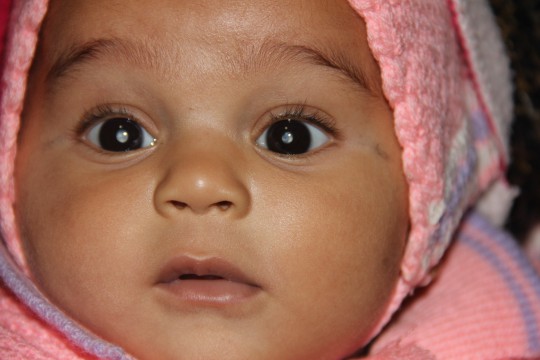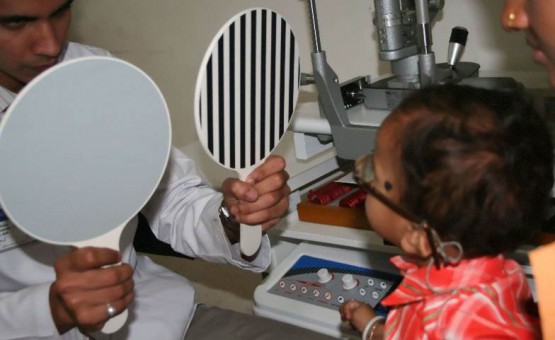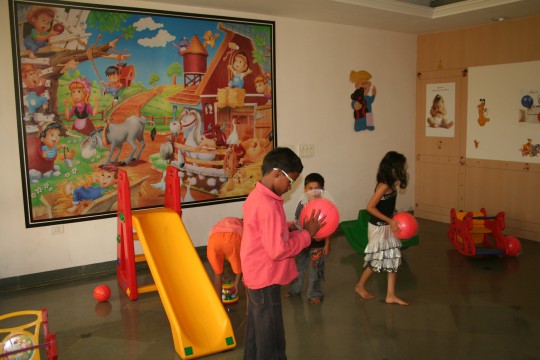Pediatric Ophthalmology
Every minute one child goes blind in this world. The situation is made worse by the fact that 54% of this blindness is reversible.
In pursuit of our commitment to reduce childhood blindness with quality eye care services, a full fledged pediatric ophthalmology unit was started in collaboration with ORBIS which is an international non-profit organization committed to reducing childhood blindness in the 0 – 16 year age group.
What is the need for a separate unit for children? The eye of a child is not just a small adult eye, but it has several aspects unique to this age group. The treatment of several ailments including refractive errors, lazy eye (amblyopia), squint, pediatric cataract, pediatric glaucoma, ptosis and several other childhood disorders is being done with a view to providing lifelong vision to the children
The department is equipped with all the instruments and devices needed in such a setup. Vision screening charts specially designed to check vision in the very young children have been procured. These include Lea® gratings and symbols. Other special tests of vision like Worth 4 dot torch and Randot® stereoacuity charts are also available. A separate play area has been created with special emphasis on child safety. We have world class operating theatres with anesthetist back up. Over a thousand children have already undergone surgery for various eye diseases at our institute.
Reaching out…
Early detection of eye problems is essential to prevent lifelong blindness. With this view in mind, school screening program was started in August 2007. Our committed team carries out the program in and around Raipur.
Common problems in school going children:
What can affect a child’s eye?
• Premature babies: Any child born before 32 weeks of pregnancy or where the birth weight is less than 1500 grams is at risk of losing vision due to ‘Retinopathy of prematurity’. Timely intervention with lasers or an eye surgery can save many of these eyes. For that to happen, such children should be examined within 4 weeks of their birth or 32 weeks after conception, which ever is earlier.
• Common eye problems in infancy and preschool age:
- Developmental cataract: Cataract in children is less common than in adults, but not rare. Most of these cases will need cataract surgery at the earliest to prevent loss of vision.
- Congenital nasolacrimal duct obstruction (Watering eyes): This is a common condition in children. Almost 90% of cases get cured with massage alone. A few cases need a procedure called probing and an even lesser few might need surgery later.
- Congenital glaucoma: Raised eye pressure in children due to improper development of the eye’s drainage system is termed congenital glaucoma. This can lead to an increase in size of the eye and nerve damage. It is important to detect this condition early and early surgery can significantly improve the child’s visual future.
- Squint (Crossed eyes): Squint is a misalignment of eyes where the two eyes are pointed in different directions. Squint can be corrected with eye glasses, eye exercises and surgery. If the child with is not treated at the appropriate time, permanent decrease in vision can occur later in life.
- Ptosis: Drooping of the eyelids is called Ptosis. The lid can cover the pupil and lead to decreased vision in that eye. It is important to surgically correct the eye lid position before it interferes with vision development.
All these conditions carry a risk of lifelong blindness if not intervened early.
• Common problems in school going children: Though any of the conditions presented above can afflict this age group also, it is refractive errors and amblyopia (Lazy eye) that take centre stage in this group.
- Refractive errors: In this condition light rays coming into the eyes fall either in front or behind the retina leading to blurring of vision. Today, 20-30% of all school going children in urban areas have refractive error. The different types of refractive errors include near sightedness (myopia), far sightedness (hyperopia) and astigmatism. These conditions can be treated easily with spectacles. Many parents question the need for glasses in very small children. Even the smallest child will wear glasses if it is good for them. Children do give initial resistance but persistence always leads to success!
- Amblyopia: Poor vision in one or both eyes due to uncorrected refractive error, squint or other conditions that prevent light from going into the eye is called amblyopia or lazy eye. Lazy eye needs treatment with appropriate eye glasses, and special techniques like patching therapy. This therapy is most effective in the first 8 years of life. However, it is always better to prevent amblyopia, and the easiest way to prevent amblyopia is by having your child’s eyes examined by an ophthalmologist before the child starts going to school.




